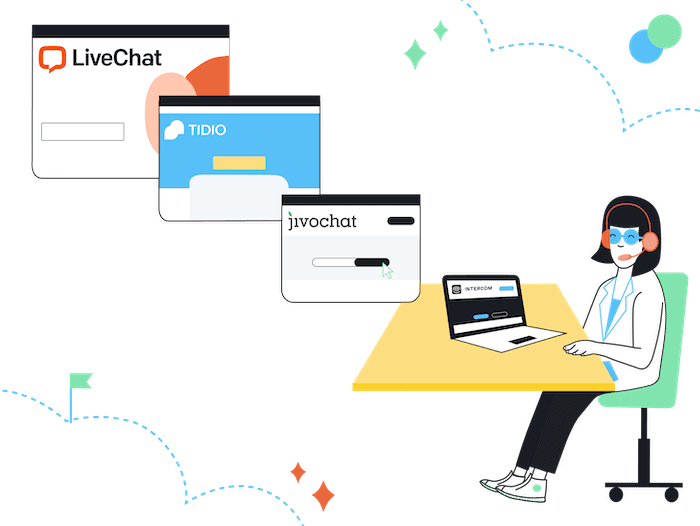Tooltester is supported by readers like yourself. We may earn an affiliate commission when you purchase through our links, which enables us to offer our research for free.
Live chat isn’t the future — it’s the now. More customers use live chat and expect brands to offer it. A 2020 report shows prospects are spending nearly 12 minutes in a live chat session on average. And the average customer satisfaction rate is 83% (and even higher for co-browsing — 88% satisfaction rate).
So adding live chat to your suite of customer service and support features should be on your list (if it isn’t already).
One popular platform you’ll find is Intercom. It comes with all the features a company needs, including:
- Chat messenger and email support
- Dashboards with reports, including behavioral data
- Shared inboxes to keep your team on the same page
- Conversation routing bots to direct interactions
- Conversation ratings and tags to monitor satisfaction and topics
But let’s face it — it’s not the most small-business-friendly. The biggest setback for many small businesses is their budget. And Intercom’s starter package demands a large chunk of it at $74/mo (if you agree to bill annually).
Then if you want additional features, like Product Tours, WhatsApp, and Surveys, the price rises to $331/mo. Intercom offers a free 14-day trial, but let’s be real — that’s not enough time to see its impact to justify the price.
So this leaves small businesses in a conundrum of needing live chat to appeal to customers, and not having enough budget to afford the big platforms. The good news is you have alternative options that may fit your budget better.
Tooltester’s mission is to find and test the best online business tools (so you don’t have to). We found the most affordable and reliable Intercom alternatives, and our reviews are impartial — unlike other lists on Google written by Intercom’s competitors.
So on that note, let’s check them out!
The top 10 Intercom alternatives
Short on time? Check out this quick list of Intercom’s alternatives and why we picked them:
- LiveChat: Best overall pick for having all the features a small business needs without the hefty price tag of Intercom
- Tidio: Provides automation and chatbot features small businesses will find helpful — plus, it has a new ticketing solution
- JivoChat: Offers tons of useful chat features, plus it has a free plan
- Userlike: Ideal for small businesses in the EU that desire lots of data
- Olark: Popular solution that offers advanced analytics
- Pure Chat: Has affordable plans for multiple users and it’s easy to use
- Smartsupp: Comes with a video recording feature — a unique touch to offer better customer service
- LiveAgent: Has advanced helpdesk features (over 130) and integrations (200+)
- HelpCrunch: Provides tons of features at affordable prices
- HubSpot: Tight CRM integration and chatbots offered
Want to know which is best for your business? Then here’s a detailed breakdown of each Intercom alternative.
The best Intercom alternatives: The breakdown
There are dozens of live chat platforms for small businesses to pick from. But these are the top 10 that made it to our list.
1. LiveChat

LiveChat is perfect for small businesses. It doesn’t have all the bells and whistles of Intercom, but offers enough features for businesses with a tighter budget.
The front-end design is clean and intuitive, allowing you to switch between chats, tags and canned messages, and send files seamlessly. The platform’s also easy to set up, and integrates well with its helpdesk, knowledge base, and chatbot solutions (note that these are charged as separate products).
LiveChat boasts a long list of happy customers, including Sephora, which used its platform to increase its average order values by 25%.
Pros of LiveChat:
- Massive suite of chat tools, including message sneak peeks, inactivity messages, chat transfer, ratings, and more
- Customer engagement tools include targeted messages, routing rules, messaging mode, chat history and transcripts, and more
- Reliable and robust chat security and privacy
- Reporting and analytics tools such as chat reports, data summaries, ticket reports, customer reports, and more to help monitor business performance
- Over 200 integrations with other tools your business might already use, plus apps to enhance your chat services (e.g. cobrowsing, payment processors, automations etc.)
- Offers many plugins that allow easy integration of the chat widget to your website or newsletter
- Offers advanced triggers and the ability to send rich messages with images, animations, and action buttons
- Can set up chat widgets in nearly 50 languages
Cons of LiveChat:
- The price is cheaper than Intercom, but still higher than other alternatives
- The dashboard appears busy and the amount of features can be overwhelming
- Helpdesk, chatbot and knowledge base are an additional cost. Other providers (like Tidio) include this as part of their regular plans
LiveChat’s prices are transparent — each plan is per month, per agent, but discounted annual plans are also available:
- Starter: $20/month/agent when billed annually. Comes with 60-day chat history, basic widget customization, data security, and ticketing system
- Team: $41/month/agent when billed annually. Comes with unlimited chat history, basic reporting, agent groups, and the ability to use LiveChat on multiple websites
- Business: $59/month/agent when billed annually. Comes with advanced reporting, staffing prediction, and work scheduler
- Enterprise: Must call for a quote (no monthly option). Comes with dedicated account manager, security assistance, HIPPA compliance, and product training
Want to know more? Read our in-depth LiveChat review.
Otherwise, you can sign up for LiveChat’s free trial here.
2. Tidio

Tidio’s only been around since 2013 and it’s already in the top two on our list. Why? Because it’s done an amazing job of delivering value to its customers.
It offers a simple-to-use chatbot that comes with dozens of templates — or you can build a workflow from scratch. You can even run a simulation to see how the workflow may play out on the visitors’ end.
The templates cover a range of purposes, including increasing sales, solving issues, and generating leads. Something like this would normally cost a lot, but it comes in three reasonable pricing tiers for SMBs.
And to date, it has tens of thousands of users, including Whisker Bag, which used Tidio to grow its business to $100K per year.
Pros of Tidio:
- Efficient ticketing system to help monitor, prioritize, and assign customer requests in one place
- Departments feature to help customers get to the right place sooner, rather than relying on in-chat agent transfers
- Excellent chatbots feature for automating conversations and reducing reliance on chat agents
- AI response bots that learn from your conversations and decide which answers are best in context
- Instagram and Facebook Messenger integration
- Team collaboration via real-time chat
Cons of Tidio:
- No Whatsapp integration
- No Twitter DM integration either
- The lack of advanced routing, voice calls and co-browsing features make it less suited to customer service functions
- The pricing plans are slightly confusing – see below for more details
Here’s a look at their plans:
- Free plan: Comes with live chat for conversations with up to 50 users and chatbot conversations with up to 100 users, plus email support
- Communicator plan: $25/month/agent for annual plan, for a maximum of five users. Comes with unlimited chat conversations, team departments, analytics, and live typing
- Chatbots plan: $29/month for annual plan. Comes with over 35 chatbot templates, Zapier integration, and visual chatbot editor
Want to read more? Check out our in-depth Tidio review here.
Or maybe you’re ready to test Tidio — if so, sign up for the free plan, no credit card required.
3. JivoChat
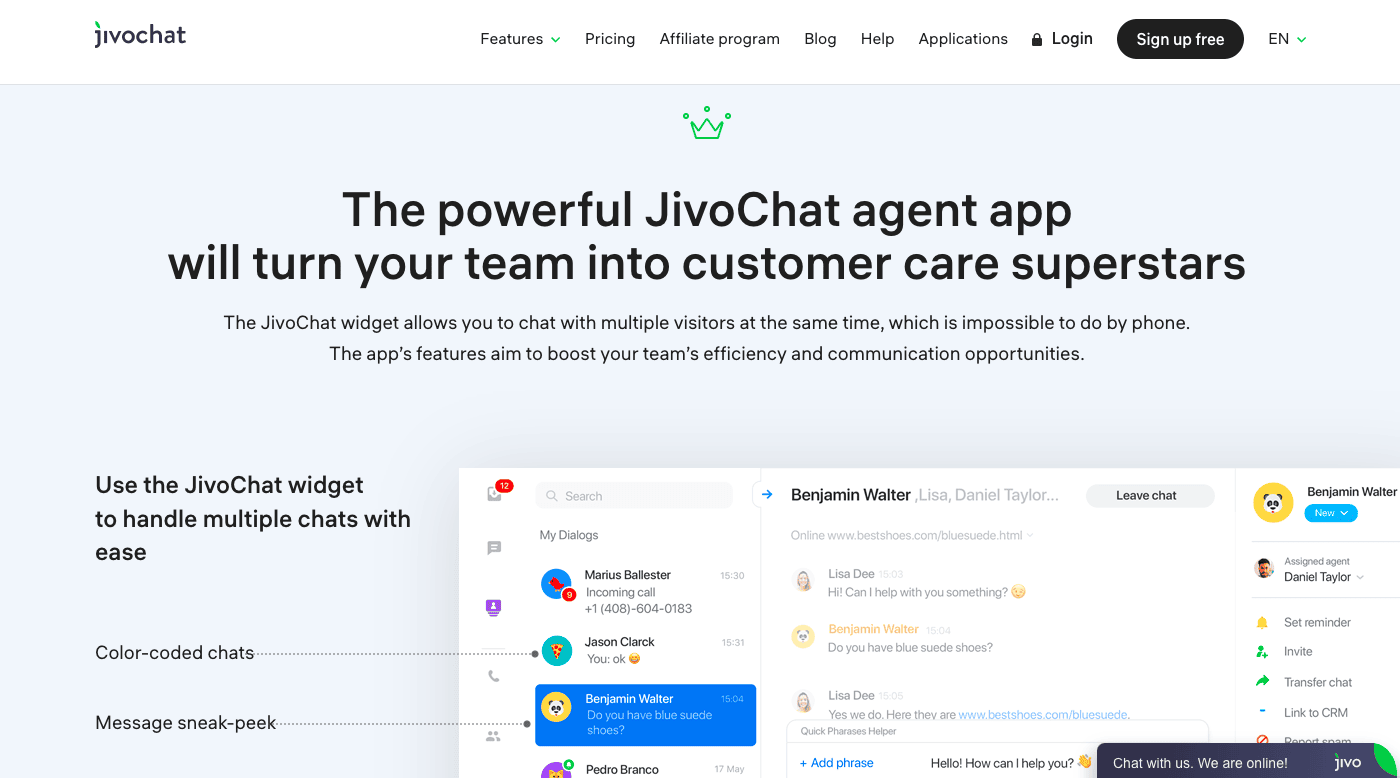
Smooth, easy-to-use interface ✅. Mobile app for iOS and Android ✅. Built-in CRM ✅. JivoChat comes with many of the bells and whistles you expect from a live chat tool.
It even has one-click calling, email integration, and chat for internal teams. It’s also compatible with multilingual sites (supports 25 languages), which is perfect if you’re a global eCommerce business.
Then if needed, you can add on a callback feature, real-time visitor monitoring, and business phone line (so you can stop getting calls on your cell).
Many customers are finding success with it, including Avilon, which increased its sales by 32% within the first month of using JivoChat (according to its site).
Pros of JivoChat:
- Lots of communication channels that appear fairly unique to JivoChat, including Apple Business Chat, Telegram, Viber, as well as video calls and telephony
- Team chat feature where you can manage internal communication
- Customizable CRM sales pipeline options
- Familiar interface that reminds you of Slack and Trello
- Attractive prices and a free plan that supports up to five agents
Cons of JivoChat:
- Can use improvement in the design, since it’s not always easy to find certain settings (but it’s not too bad)
- Some customers have reported poor customer service from JivoChat in resolving issues
- Triggered messages aren’t as advanced as in Tidio or LiveChat
Pricing options are also impressive:
- Basic plan: Available for free, allowing you to respond to customers in chat and messengers (there’s also a free 14-day trial)
- Professional plan: $19/month per agent for annual plan — comes with pre-chat buttons, advanced stats on chats and agent activity, Google Analytics integration, and multiple departments
- Enterprise plan: Must call to get a quote, comes with Jivo’s advanced features for companies with 10 or more agents
Learn more about this tool in our in-depth JivoChat review.
Want to see it in action? Check out JivoChat for free today!
4. Userlike

If you’re in the EU, then Userlike should be on your list. It’s a Germany-based live chat support software that’s fully GDPR-compliant.
Userlike doesn’t have the most exciting interface, but it comes with a suite of features you’d expect from a live chat platform. What sets it apart is the Unified Messaging offer that empowers businesses to engage with customers across sessions and channels.
There’s also a plan for everyone, including small teams, corporations, and enterprises (and even those not ready to fork over their dollars yet). Those that do are seeing great results with Userlike — for instance, Cyberport saw a 5x increase in conversions after adopting it.
Pros of Userlike:
- Hosted in Germany, which means they baked in data privacy from the ground up
- Easy to switch from chats to video calls
- No-code automation solutions to help connect customers to the right help from chatbots to smart FAQs
- Easy conversation management with customizable notifications
- Integrate multichannel support including Instagram, WhatsApp, Messenger, and Telegram
- Calls with screen sharing to improve product presentations and live support
- Multilingual features like live translations and customizable texts
Cons of Userlike:
- Pricier compared to other options
- Chatbots are only available at the Corporate level and aren’t easy to set up
- Chat’s widget routers and automations aren’t as advanced as you’d expect
- Setup process isn’t as intuitive as you’d like (but they’re making improvements)
Here’s a look at the prices — note that these don’t include VAT:
- Free: Comes with all the basic features, such as website messenger, and unlimited conversations and contacts (for only one widget and one user)
- Team: $90/month when billed annually, for four users and widgets, and two messaging apps. Comes with Add-ons, WhatsApp channel, video calls, screen sharing, messaging apps, and live translation
- Corporate: $290/month when billed annually, for 10 users and widgets, and four messaging apps. Comes with AI automation hub, analytics, and chatbot
- Flex: Must call for a personalized quote — comes with white labeling, professional onboarding, and a dedicated account manager
Interested in learning more about Userlike? Check out our in-depth Userlike review here.
Or if you’re ready to give it a try, then sign up for a Userlike free 14-day trial or free plan today.
5. Olark

Olark’s a fully remote company, so if anyone gets live chat — it’s them. It was founded in 2009 and services over 12,000 businesses.
Being a vet in the chat game means it comes with everything you need and then some. One of the more peculiar features it offers is a selection of holiday themes, which allows you to add decor to your live chat so no one misses it.
Olark offers a variety of features, including chat automation (aka targeted chat) to guide visitors to the right pages. Plus, there’s a co-browsing feature, which is a one-up to enhance your customer experience.
Apparently something works because brands like Lush UK saw gains of 174% more conversions after adopting this platform.
Pros of Olark:
- Easy chat box customization to match your branding
- Setting up the chat widget is simple
- Automation rules make it easy to get customers’ solutions more quickly
- Live chat analytics that work in real time, meaning you can monitor chat volume, customer satisfaction, and agent activity whenever you want
Cons of Olark:
- It doesn’t include “PowerUp” features like language translation, co-browsing, and visitor insights in paid pricing — they’re add-ons
- Recent price hike makes it less budget-friendly
- It now requires a credit card for its 14-day trial
- Range of features could be better (e.g., lacks a ticketing system and offline messages go to email instead of the chat)
- Chat widget and dashboard look outdated
As for Olark’s prices, you can expect to pay:
- Monthly plan: $29/mo per agent, comes with unlimited chat history, agent groups, targeted chat, data security, customizable chat box, integrations, and real-time reporting
- Annual plan: $23/mo per agent
- Biannual plan: $19/mo per agent
- Enterprise plan: Must contact for quotes
- Add-ons: Available at varying rates between $29 to $99 per month
Curious to see if Olark is right for you? Read our in-depth Olark review here.
Or sign up for a 14-day free trial with Olark.
6. Pure Chat
Pure Chat is an ideal live chat platform for small businesses with a tight budget. It offers affordable plan options for multiple users. And if you’re a business owner on the go, then you’ll find the mobile app for iOS and Android a major bonus.
It also has a separate chatbot (Artibot.ai) that captures leads, processes payments, and books appointments.
With its paid plans, Pure Chat comes with real-time visitor analytics and automated chat alerts. Then it offers white labeling with the PRO plan, so you can put your own branding on it.
But with its lower price range comes fewer features. It’s a lighter live chat tool than others. But after a virtual receptionist tool acquired it, it may see new features added one day.
Pros of Pure Chat:
- Lots of customization available for the chat widget on desktop and mobile
- 30-day money-back guarantee if you don’t like using Pure Chat
- You can send SMS notifications to users regarding chats
- Real-time visitor analytics helps you identify high-value prospects on your site
- Overall, the platform is simple to use from the get-go
Cons of Pure Chat:
- You can’t remove Pure Chat branding unless you get the higher-tier PRO subscription
- You can only use Pure Chat for one website unless you go for the higher-tier subscription (whereas most other options include this in their lower-tier plans).
- User interface is confusing to navigate and the design options for the chat bar aren’t great
The cost for Pure Chat is based on the following plans:
- Growth plan: $39/mo for annual plan, then $13/mo for each additional user — comes with one website, four users, unlimited chats, 100 SMS notification, integrations, widget customization, and chat notifications
- Pro plan: $79/mo for annual plan, then $8/mo for each additional user — comes with unlimited websites, 10 users, 1K SMS notifications, and white labeling
There’s also a free 30-day trial, which is more than most live chat platforms offer.
If you’d like to learn more before you try it, then check out our in-depth Pure Chat review here.
7. Smartsupp

Smartsupp is another European live chat software — this time it’s in the Czech Republic. It’s not as big or well-known as others on this list, but has thousands of customers.
If you use Zendesk (and like it), then you’ll like Smartsupp’s interface — it has a similar design (almost too similar). The prices are attractive to small business owners, plus it comes with a free plan.
Although it’s been around for nearly a decade, it only shows two case studies on its site. One is Breno, which used Smartsupp to grow its overall revenue by 10.8%.
Pros of Smartsupp:
- Automated welcome messages to avoid long first-time responses
- Detailed live analytics with Google Analytics integration to measure chat impact
- Unique feature “Video recordings” allows you to see the movement of each visitor on your site to understand visitor behavior
Cons of Smartsupp:
- Only social media integration available is Messenger
- Free plan is very limited (1 user seat, 100 conversations a month, 14-day conversation history)
- Design of the chat bars could be better, and it limits the customizations
Here’s a look at the prices for Smartsupp:
- Free: Comes with live chat for one agent and 100 conversations per month
- Standard: $19.50/mo (annual)for up to three users, and comes with live chat, email, and FB Messenger, one-year conversation history, and unlimited chatbots
- Pro: $48/mo (annual) for three users, but upgradeable to 10 — comes with three years of conversation history, 500 chatbot notifications, and 1 automated messages
- Ultimate: Customized limits, which you must call to receive a quote for — comes with dedicated customer success manager, individual contract, and custom number of agents
Want to give it a test run? Then sign up for a free plan with Smartsupp or try a 14-day free trial.
8. LiveAgent
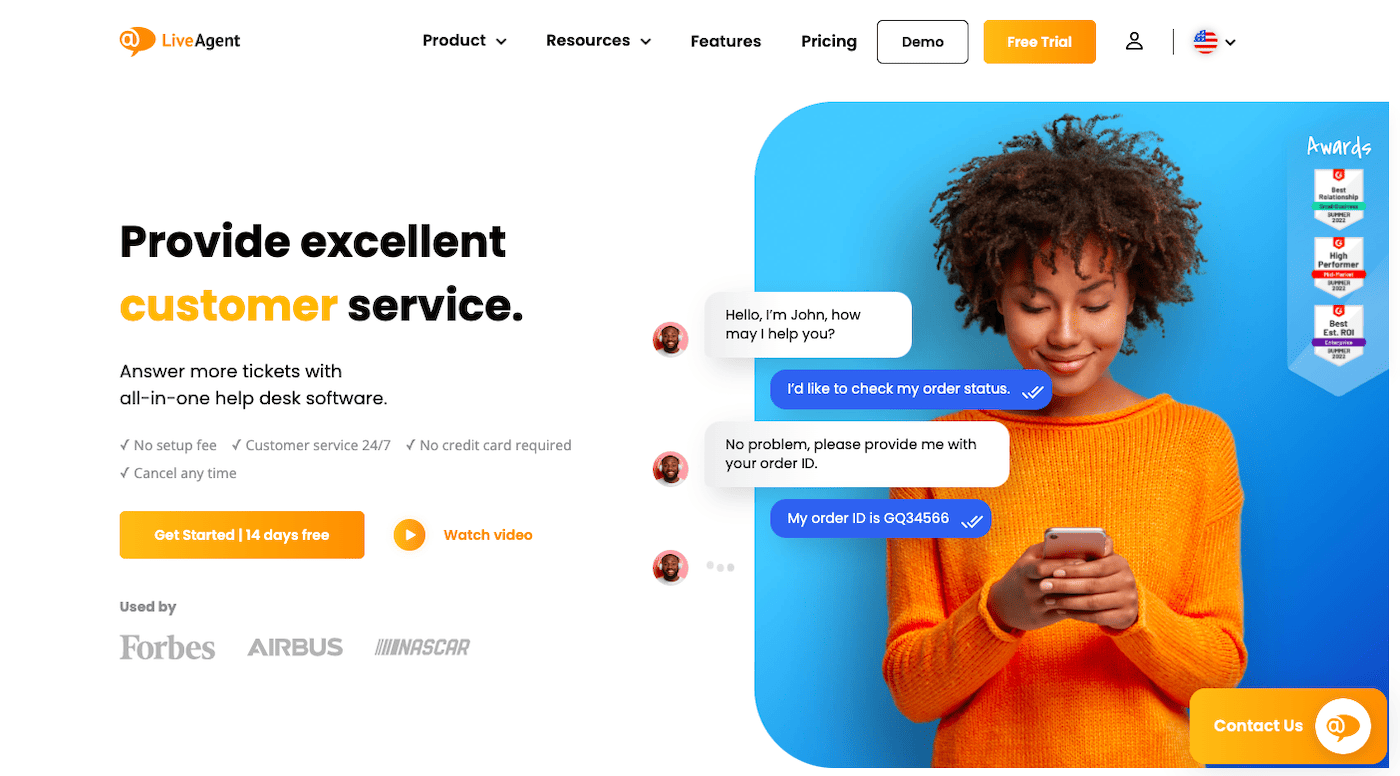
And here’s yet another live chat platform out of Europe. LiveAgent headquarters is in Slovakia and has been around since 2007. As a veteran in live chat, it boasts some neat features, like video chat and a fully integrated helpdesk, where it turns chats into tickets.
The prices are also reasonable and it has a free plan you can use (note that it has a limited ticket history). Also, LiveAgent has tons of testimonials on its site, showing it’s a promising platform.
For example, Cotswold Web used LiveAgent to grow its customer satisfaction rate to over 98% — impressive.
Pros of LiveAgent:
- Not just a chatbot, it’s an advanced helpdesk software
- A ton of channels are available, including email, chat, calls, forums, video calls, Facebook, Twitter, Slack, and Viber.
- Simple ticketing solution is fully customizable and scalable
- Social listening capabilities allow agents to respond to brand tags and mentions on social media
- Onboarding process is solid and includes a to-do list to get you started
- Video chat feature is neat, but you can also set up for voice-only calls when necessary
- Supports a large range of languages
Cons of LiveAgent:
- Customers complain the UX (user experience) of LiveAgent isn’t great, and the overall design of the interface could use updating
- Easy to get lost in all of its features
As for the plans, each has monthly pricing only (no annual):
- Free: Comes with one phone number, email, chat button, and basic reports (7 days of ticket history)
- Ticket: $15/mo per agent, comes with unlimited ticket history and email addresses, API + integrations, advanced reporting, and customer portal and forum
- Ticket + Chat: $29/mo per agent, comes with unlimited chat buttons, feedback management, real-time visitor monitoring, chat satisfaction surveys, and time tracking
- All-inclusive: $49/mo per agent, comes with video calls, IVR, hardware IP phone, unlimited call recordings, and call center support
Then if you want to add social media channels, you’ll pay $39/mo per account for each channel (unless you opt for the All-inclusive plan).
Ready to check it out? Sign up for a free 14-day trial (no credit card needed).
9. HelpCrunch
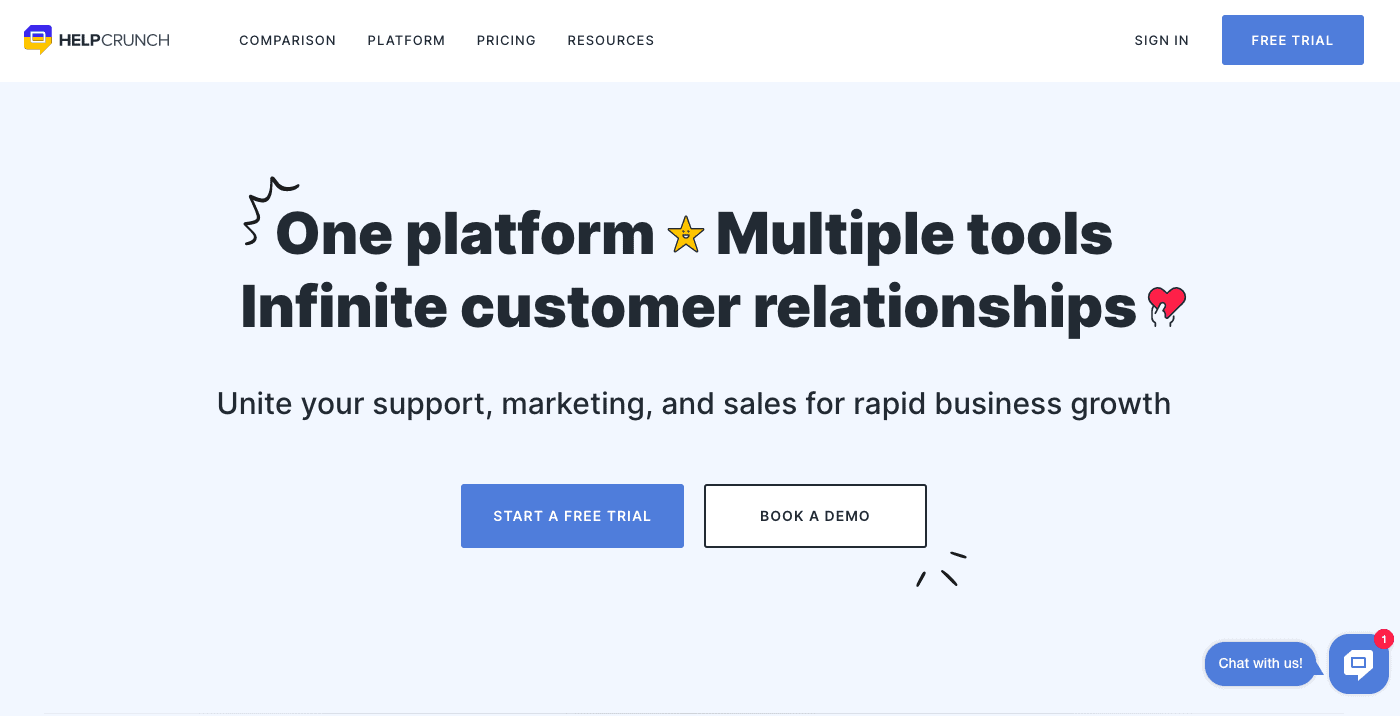
Scaling businesses like HelpCrunch, because it doesn’t penalize your growth. So whether you’re trying to converse with a few dozen or a few thousand people, you can do it without breaking your budget.
Its prices don’t limit your conversations — it charges by the number of users on your team. All prices are transparent, so no need to worry about hidden fees and surprise bills.
Its platform comes with a shared inbox you can use to communicate across multiple channels. Then you can easily switch between email and chat conversations.
The interface is user-friendly, allowing anyone to jump on and use it right away. Also, if you’re already on Intercom or another platform, HelpCrunch will integrate all of your contacts, email templates, and automation to its platform… for free.
You’ll find several interesting case studies on its site, including one from FitLap that earns €14,8 per €1 spent on HelpCrunch.
Pros of HelpCrunch:
- All the usual features of helpdesk software with the bonus of mobile app & SDK (collection of tools that help programmers create software for a specific platform) for in-app support
- Lots of communication channels are available with more on the way, including not-so-common Tumblr
- Offers live chat in multiple languages
- Allows you to create granular segments for automated emails
Cons of HelpCrunch:
- HelpCrunch pricing and features seem deliberately limited to encourage you to go for the annual-only Unlimited plan
- Lacks real-time view of onsite visitors (but this is on its roadmap)
There are three plans to choose from (note you must pay extra for outgoing emails):
- Basic: $12/mo per agent annually (no chatbot or multilanguage knowledge base included). Comes with one widget, three auto messages, three pop-ups, full customization, and basic automation
- Pro: $20/mo per agent annually. Comes with chatbot flows, and advanced customizations and automation
- Unlimited: $495/mo annually for unlimited agents, widgets, pop-ups, and automated messages (no monthly option)
If you’d like to give it a test run, then sign up for a free trial today.
10. Hubspot
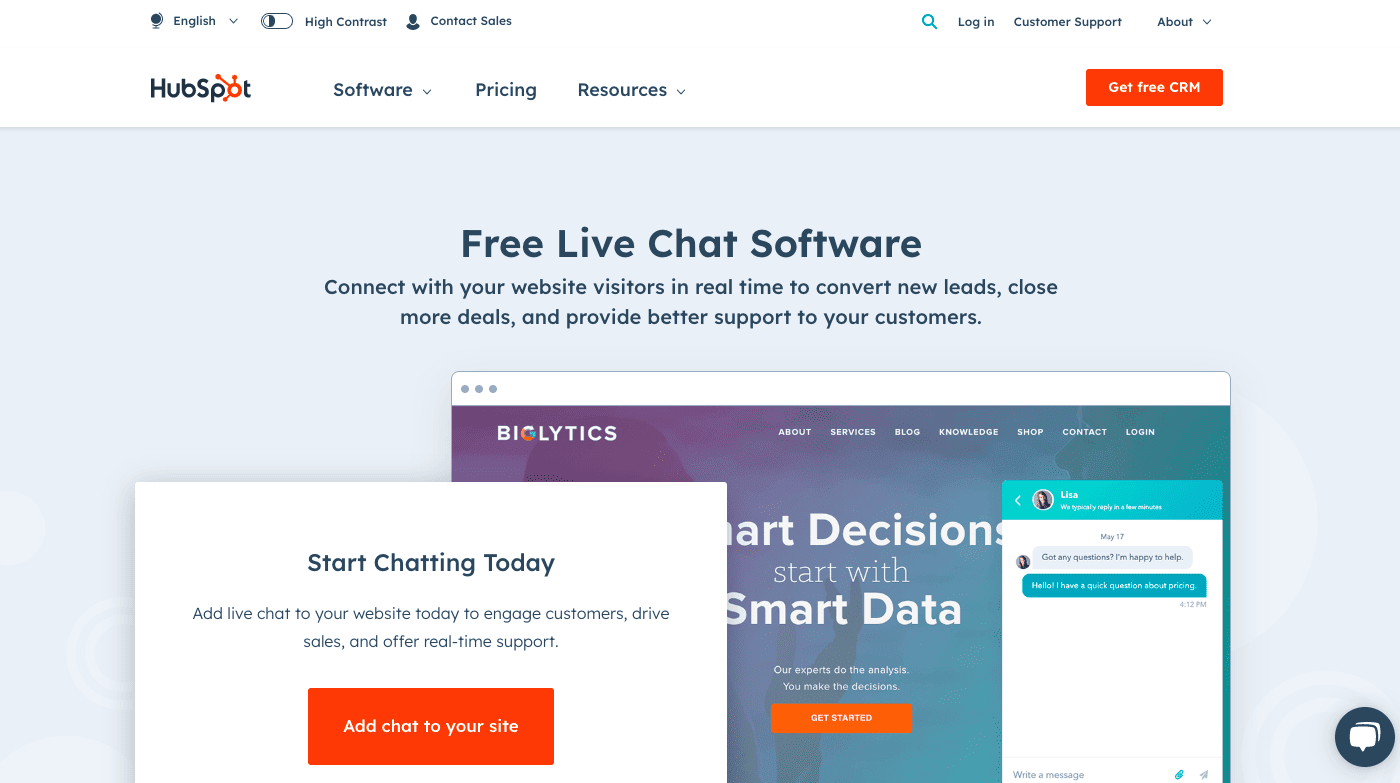
HubSpot is the ideal live chat platform if you want to build automated marketing campaigns to supplement your live chat feature. It comes with automated chat flows, universal inbox, and Facebook Messenger integration.
If you don’t operate around the clock, then using its canned responses is useful to help visitors while you’re away. Plus, it comes with smart chatbots that make booking calls, providing customer support, and qualifying leads a breeze.
HubSpot’s been around since 2004 and has customers in over 120 countries. And for good reason — it offers excellent features and amazing rates (including a generous free plan).
Pros of HubSpot:
- HubSpot is a massive service, offering not just helpdesk solutions, but also marketing, CMS, sales, and operations solutions, allowing you to put a lot of business operations under the HubSpot umbrella
- The Customer Service software option has all the helpdesk features you need, including live chat, VoIP calling, omnichannel messaging, and a knowledge base
- Pricing is transparent, and small businesses could easily get by with the free tools option
- Can target visitors based on factors like location or device
- Integrates with your knowledge base for self-serve customer support
- Supports over 30 languages, which you can automate to display based on the URL, browser language, or country
Cons of HubSpot:
- While pricing is transparent, there are a lot of options, including bundle deals with other HubSpot services, which can be confusing (and pricey)
- New users may find all the features overwhelming (such as the multi-window inbox view)
So what are the fees like? Take a look:
- Free Tools: Choose between various free tools for marketing, sales/CRM, customer service, customer management, and data syncing
- Starter: $45/mo annually for two seats (additional seats charged extra). Removes HubSpot’s branding and includes advanced chatbots and custom bots. Comes with form and email automation, landing pages, email marketing, and in-app chat support
- Professional: $450/mo annually for five seats (additional seats charged extra). Includes custom bots and advanced chatbots, plus full range of customer service features.
- Enterprise: $1,200/mo annually for 10 seats. Comes with advanced team management features, single sign-on, Salesforce custom object sync, sandboxes, and AI-powered conversation reporting
Ready to get started? Try Hubspot for free.
Do I need an Intercom alternative?
Choosing whether to use Intercom depends on your needs and budget. It comes with features like chat and email support, in-product messages, shared inbox, help center, targeted outbound emails, and reporting dashboards.
If that’s not enough, here’s a quick overview of Intercom’s pros and cons.
Pros of Intercom:
- User-friendly interface
- Integrates with over 300 apps
- Can use customer data to create personalized engagements
- Use a mix of chat and messages, which you can add to your product, website, or app
- Plenty of resources to help you get started, including a help center and academy with deep-dive courses
- Provides company and behavioral data, which you can view in your reporting dashboards
Cons of Intercom:
- Expensive for small businesses ($74/mo billed annually)
- Must pay for additional features, like WhatsApp, Product Tours, and Surveys
- Starter plan limits you to 50,000 people reached per month (must pay $50/mo per 1K reached) and a max of 25 seats (at $19/mo per seat — it includes the first two seats in base price)
- Setting up segments and tying messages to actions is challenging
- Consistently ups its price without a grace period or the option to opt-out
- Team dashboards can be unintuitive for new users
- Onboarding isn’t the best, some complain it’s difficult
Which Intercom alternative should I choose?
If you decide to go with an Intercom alternative, then our list of live chat tools is a great place to start. Many come with free plans or trial periods, which you should take advantage of. Explore each platform to see which matches your particular business’ needs.
To help you along, here’s a recap of the various options you have:
- For tight budgets: Tidio, JivoChat, Smartsupp, HelpCrunch
- For ease of use: LiveChat, Pure Chat
- For advanced chatbots: HubSpot, Tidio
- For multichannel: JivoChat, Userlike, LiveAgent, HelpCrunch
- For multilingual sites: JivoChat, LiveChat, Olark, HelpCrunch
- For the best all-around: LiveChat
- For advanced data and real-time analytics: Smartsupp, Olark
- For advanced helpdesk: LiveAgent, HelpCrunch, HubSpot, Tidio, JivoChat
- For tool integrations: JivoChat, HubSpot
- For video recordings: Userlike, Smartsupp
- For EU-based businesses: Userlike, Smartsupp, LiveAgent
- For free plans: Tidio, JivoChat, Userlike, Smartsupp, LiveAgent, Hubspot
Hopefully, this list gives you the head start to find a live chat solution that’s a better fit for your small business than Intercom. Once you test out a few, let us know your take (and final decision) in the comments below.
THE BEHIND THE SCENES OF THIS BLOG
This article has been written and researched following a precise methodology.
Our methodology